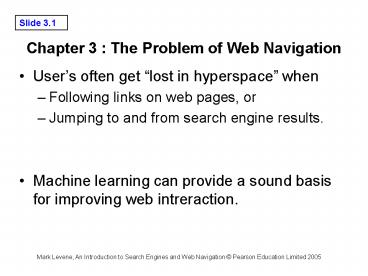Chapter 3 : The Problem of Web Navigation
Title:
Chapter 3 : The Problem of Web Navigation
Description:
Mark Levene, An Introduction to Search Engines and Web Navigation Pearson ... be a balance between web site navigability and the business objectives of the site. ... –
Number of Views:21
Avg rating:3.0/5.0
Title: Chapter 3 : The Problem of Web Navigation
1
Chapter 3 The Problem of Web Navigation
- Users often get lost in hyperspace when
- Following links on web pages, or
- Jumping to and from search engine results.
- Machine learning can provide a sound basis for
improving web intreraction.
2
Getting lost in hyperspace
- Figure 3.1 The navigation problem
3
Getting lost in hyperspace
- Figure 3.2 Being lost in hyperspace
4
The Naïve Bayes ClassifierAutomatic
classification of web pages can widen the scope
and size of web directories
5
Trails should be First-Class Objects
- Figure 3.3 Example web site
6
Trails should be First-Class Objects
- Figure 3.4 Four trails within a web site
7
Trails should be First-Class Objects
- Figure 3.5 Query results for mark research
8
Trails should be First-Class Objects
- Figure 3.6 Relevant trail for mark research
9
Markov chains
- Markov chains have been extensively studied by
statisticians and have been applied in a wide
variety of areas.
10
The probabilities of following links
- Figure 3.7 Markov chain for example web site
11
The probabilities of following links
- Figure 3.8 Two trails in the Markov chain
12
The probabilities of following links
- Figure 3.9 Probabilities of the four trails
13
The relevance of links
- Figure 3.10 Scoring web pages
14
The relevance of links
- Figure 3.11 Constructing a chain from scores
15
Conflict Between Web Site Owner and Visitor
- The web site owner has objectives related to the
business model of the site, e.g. selling products
in an e-commerce site. - The objectives of visitors are related to their
information needs, e.g. gathering information in
an e-commerce site. - Web site owners would like to identify their
visitors (e.g. via cookies), while visitors may
prefer to remain anonymous.
16
Conflict Between Semantics of Web Site and
Business Model
- E.g. the objective of an e-commerce site is to
convert visitors into customers. - But to keep visitors satisfied a web site must
provide solutions to users information needs. - There must be a balance between web site
navigability and the business objectives of the
site.































